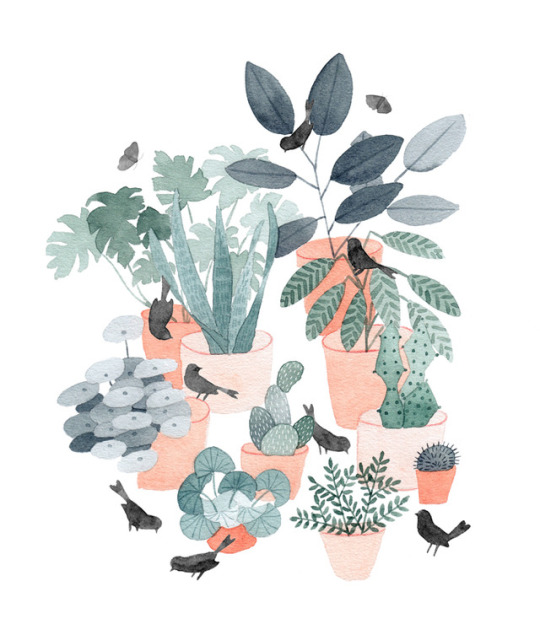Professional communicator in training. Creative thinker. Strategic doer.
Don't wanna be here? Send us removal request.
Text
Digital Stakeholder Engagement for Environmental Sustainability and Economic Growth
The power of digital technologies for human advancement and development is limitless. This may excite a lot of people, while turning others off completely.
The question is: how can we make use of communication technologies in collaboration to achieve a common vision? How to ensure these devices will work with rather than against us? Is that even possible?
Beyond that, what is the potential of digital stakeholder engagement (DSE) for economic and financial sustainability - the long term growth and development of business & organisations?
Coming up next:
A common future
Coming together
A transformative approach
Stakeholders of sustainability
Implications: Power dynamics
Towards sustainability: potential ideas for DSE
Beyond environmental: sustainable growth & development?
Where we are heading: the future of DSE.
A common future
What is the one thing that every single one of us has a stake in? The answer, you know it, is environmental sustainability.
Whether you are an environmental activist or climate change denier, you cannot help but see its disastrous effects being increasingly more common in many parts of the world.

The Great Barrier Reef (Courtesy: independentaustralia.net)
Look in your own ‘backyard’ for a second. Did you notice any difference in seasonal changes? Has spring vanished and given way to summer much earlier than usual? What about this year’s winter? Was it much colder for longer than previous years, or not even cold at all?
Coming together
The fact is that these changes affect us all, today, tomorrow or 5-10 years from now. Can communication technologies help with this? In what ways?
You have probably heard this before. Climate change and sustainability is no single country’s problem. The first step: to admit we need to work with one another.

(Courtesy: giphy.com)
A transformative approach
How can we expand the concept of stakeholder engagement as we know it, to include higher stakes and a wide range of stakeholders?
Rather than a management-driven approach centring on the organisation, in the digital age, we need a new perspective that will be transformative for sustainability.
According to Lock & Seele (2016), the new lens puts sustainability at the core of stakeholder engagement, in which everyone has a stake in a ‘common future’.
DSE therefore requires new parameters: big data, algorithms, machine learning, analytics, and issues surrounding transparency and privacy.
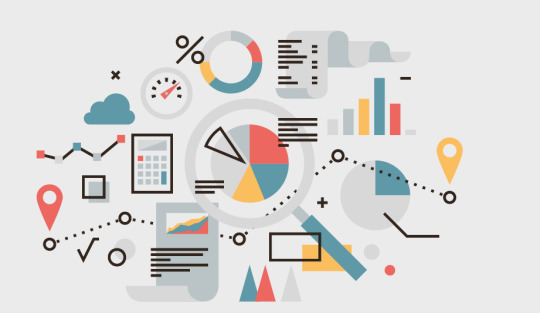
Stakeholders of sustainability
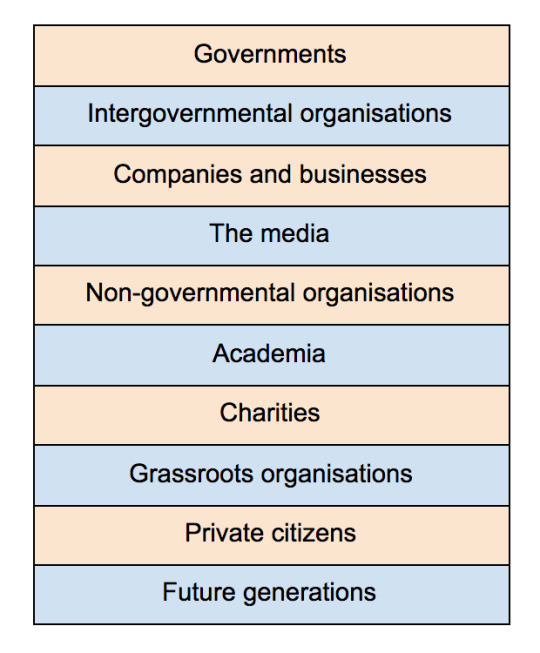
Implications: Power dynamics
Stakeholders do not all have equal power. In some cases, the government does not have as much power as other actors, such as private companies - powerful corporations.
Many even compete with each other in the digital world. One example is Google, who is at times more powerful than the national government itself.
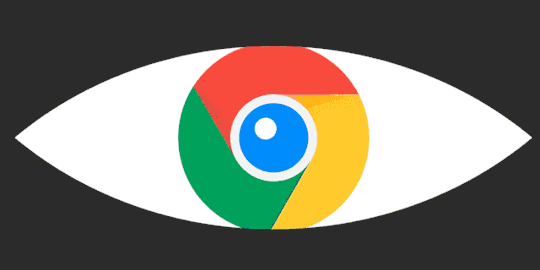
(Courtesy: Electronic Frontier Foundation at eff.org)
Google Crisis Response is an environmentally driven technology that is used to gather and distribute information to affected people during natural disasters, sometimes even more efficiently than the government.
Despite the advantage, this power dynamic is not a constant one. To reclaim some power, governments can sometimes use their regulatory and administrative power: take matters into their own hands, taking advantage of the private infrastructures and info systems.
For instance, in 2018, the Indian government began teaming up with Google to improve flooding response, making use of their AI, machine learning and technical expertise.

Google’s flooding updates in South India’s Kerala (Courtesy: localguidesconnect.com)
Towards sustainability: ideas for DSE
A global participatory platform
One way we can make use of digital media for sustainability is to have a global participatory platform. This is based on the logic that dialogue = means of deliberation and openness. When we have effective dialogue, we can work better together.
Having open discussions about sustainability and the real issues and consequences it has on human lives, more people around the world can contribute to advancing, promoting and achieving sustainability.
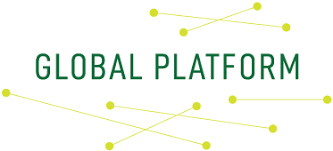
Digital sustainability panopticon
Coinciding with the prediction that ‘tracking’ (aka surveillance technologies) will come to increasingly shape our future, this idea is based on the thinking that surveillance carries an incredible habit-changing power.
A prominent example is China’s ‘social credit’ system, which takes place on the national social media platform WeChat. It works by having citizens monitoring and (literally) rating one another, rather than state agents conducting surveillance themselves.
Utilised correctly, this can bring about a series of concrete behaviour changes that will contribute to sustainability. However, this kind of idea is also at great risk of being used to control people.

(Courtesy: visualcapitalist.com)
Beyond environmental: sustainable growth and development
Collaboration and co-creation is at the heart of stakeholder engagement. What does this mean for businesses and organisations who are aiming for sustainable growth?
Organisations can create a digital network of value co-creation (DVN) to engage end customers and third-party actors in co-creation activities. Providing co-designing opportunities for these stakeholders, they can gain a competitive advantage in the market.
“Based on collaboration and competition, dynamic and co-evolving communities allow the various actors to work together and to create and capture new value” (Blaschke et al. 2017, p. 455).
In reality, this does not have to be literal. The DVN can take many forms: digital platform, online marketplace, and engagement program etc. What does this look like in real life?
McDonald’s MyBurger
The MyBurger initiative was a hugely successful project aimed at consumer - public participation. The idea: consumers come up with their own recipe for a burger, enter the competition and get votes from the public. Winning creation gets featured on McDonald’s limited edition menu.
This was a smash in countries such as Germany, the UK and Sweden. Not only does McDonald’s benefit from the publicity, participants including chefs, restaurant owners and everyday people get to promote themselves and gain popularity from the competition.

(Courtesy: thisisnotadvertising.wordpress.com)
YouTube’s Creator partnership program
YouTube launched this program in 2014 which now has 2+ million members. Video creators (or YouTubers) who sign up for this program can make money from their videos via sponsorships and ad placements.
How much money you make depends on various factors: CPM (cost per 1,000 impressions), how often you upload, how much engagement you have (ad click-through rates), and the quality of engagement (watch hours).
The YouTube algorithms favour those who upload regularly by recommending their videos more widely, which in turn boost their CPM, engagement rates and ultimately, income.
YouTubers are the reason why many stay on the platform, consuming hours of content. It makes money from ad revenues and/or users paying for premium subscriptions. A genius business model and a great example of corporations maximising value through co-creation.
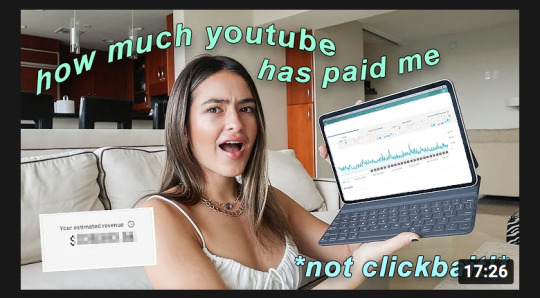
(Courtesy: Natalie Barbu on youtube.com)
See more: How Much YouTube Pays You For 1,000 Views In 2021
LEGO’S Ambassador program
Similarly, LEGO has a large-scale global ambassador program of 360 user groups, 5000+ topics and nearly 300 events taking place around the world, including festivals, library displays and escape rooms.
Members are adults who use LEGO bricks as a creative medium. Some build at home with family and friends, others meet up with people and share their passion outside. This ‘adults’ club’ has been active for over 30 years.
So, where are we heading? The future of DSE
From our discussion thus far, the future of DSE will most likely be shaped by:
Big data: metrics and indicators as new ways of controlling, reporting and monitoring performance
Stakeholder engagement beyond the corporational level: government-centred or centre-less systems
Unequal power relations between stakeholders -> increased consumer power and competitive advantage, while simultaneously leveling out the playing field (lower barriers to entry thanks to technology and diminished operating cost)
New stakeholder experience: blurred lines between virtual/physical reality -> new power dynamics
Digital co-creation maximising value for networks beyond temporal, organisational and spatial boundaries.
-END-
Bibliography
Burke, M. E., O’Callaghan, S. & Quigley, M. 2013, ‘The business of digital storytelling’, Journal of Systems and Information Technology, vol. 15, no. 4, pp. 347-367, DOI 10.1108/JSIT-04-2013-0009
Blaschkle, M., Riss, U., Haki, K. & Aier, S. 2017, ‘Design principles for digital value co-creation networks: a service-dominant logic perspective’, Electronic Markets, vol. 29, pp. 443-472, https://doi.org/10.1007/s12525-019-00356-9
Dahan, N. M., Doh, J. P. & Raelin, J. D. 2015, ‘Pivoting the role of government in the business and society interface: a stakeholder perspective’, Journal of Business Ethics, vol. 131, no. 3, pp. 665–680.
Helbin,g D. 2012, ‘The future ICT knowledge accelerator towards a more resilient and sustainable future’, In P. Ball (ed.), Why society is a complex matter, Springer, Heidelberg, pp. 55–60.
Lock, I. & Seele, P. 2017, ‘Theorising stakeholders of sustainability in the digital age’, Sustain Sci, vol. 12, pp. 235-245, DOI 10.1007/s11625-016-0404-2
Matchar, E. 2016, ‘Wired Founder Kevin Kelly On The Technologies That Will Dominate Our Future’, Smithsonian Magazine, Viewed 18 October 2021, https://www.smithsonianmag.com/innovation/wired-founder-kevin-kelly-on-technologies-that-will-dominate-our-future-180959708/
Sachs, S. & Maurer, S. 2009, ‘Toward dynamic corporate stakeholder responsibility’, Journal of Business Ethics, vol. 85, no. 3, pp. 535–544.
https://reliefweb.int/report/india/india-s-government-teams-google-improve-flood-management
https://www.wired.com/wiredinsider/2014/06/youtubes-elite-creator-partner-program/
9 notes
·
View notes
Text
Shameless Media: A Start-up's Guide To Digital Stakeholder Engagement
OVERVIEW
Today’s businesses exist in a world where everything is rapidly changing. How organisations communicate with stakeholders, and vice versa, have been transformed by the digital age.
Not only are stakeholders powerful and tech-savvy, thanks to digital media, they now also have direct contact with companies and organisations 24/7 (Ozer 2020).
Companies therefore are much more accountable for their conduct and value (Tench & Yeomans 2017). This can either play to their advantage, or hinder it in a critical way.
As such, businesses need to foster relationships with stakeholders by leveraging the power of digital media. The goal is to have a community of people who support the organisation, who resonates with the brand’s value and message.
An example of modern organisations championing this is Shameless Media. Utilising digital media, Shameless engages with their stakeholders through strategic branding and content marketing.
How can we capture people’s hearts and minds in an attention economy? Let’s learn from this millennial start-up.
CASE STUDY: SHAMELESS MEDIA
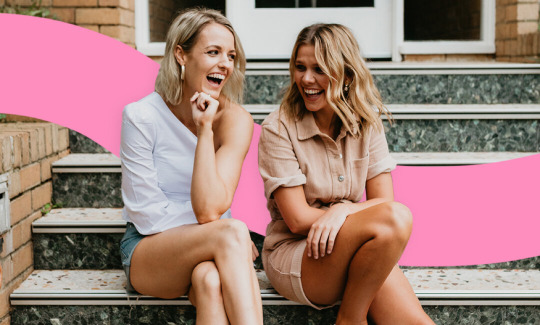
Profile
Shameless Media (SM) is a millennial gen Z’s destination for all things digital content. Operated in Melbourne by a team of five young women, the company was founded in 2019 by writers Zara McDonald and Michelle Andrews.
Although relatively young, the podcast venture has accumulated a consumer base of over 20 million listeners, plus a growing community of 220,000+ followers across Facebook, Instagram and LinkedIn. SM also recently created a brand-new agency for content creators and influencers, The Sana Agency.
Stakeholders
Since its inception, the podcast has not had a single episode that has not been sponsored (Forbes 2021). More notably, Shameless listenership is overwhelmingly 94.7% women in their 20s (Gillezeau 2021).
SM's key stakeholder groups thus include:
1. Consumers: audiences, readers, listeners; and
2. Sponsors: collaborators, business partners.
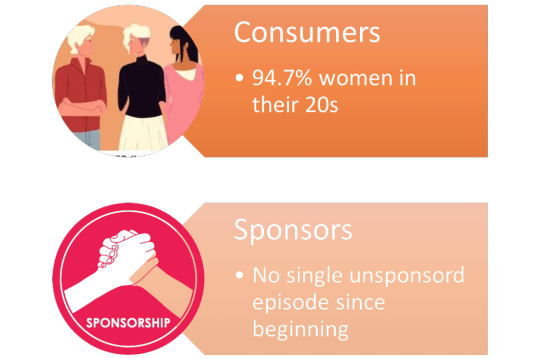
Current digital operations
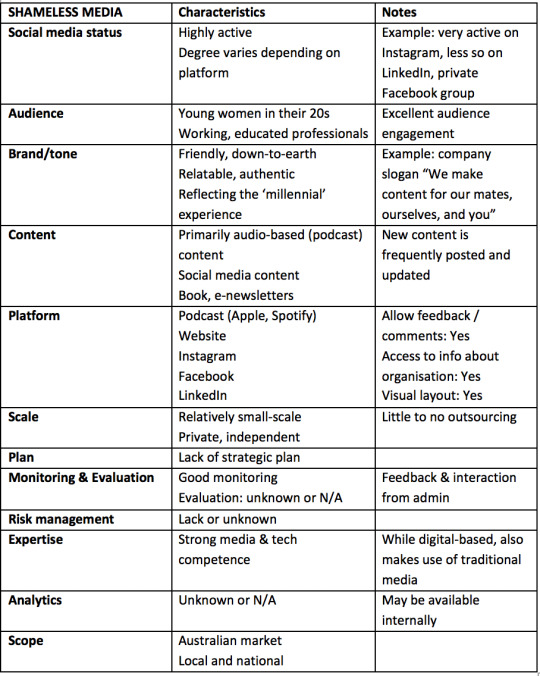
PLATFORMS
1. Podcast
At first glance: Eye-catching cover. Good tag line (“The pop culture podcast for smart people who love dumb stuff”). Almost always seen in the Top Charts.
My thoughts: I was surprised to discover how new the podcast is. Its popularity, large growing number of listeners and content quality make Shameless seem a lot more established.
Open and honest, the hosts are not afraid to let audience knows where they stand on critical issues (feminism, politics, climate change etc.). New episodes are regularly scheduled which is good for audience retention.
As a consumer, I am drawn to the show/company for their seeming authenticity and relatability. Not to mention the well-balanced research that allows audience to form their own opinions without being spoon-fed. 10/10 recommend.
2. Website
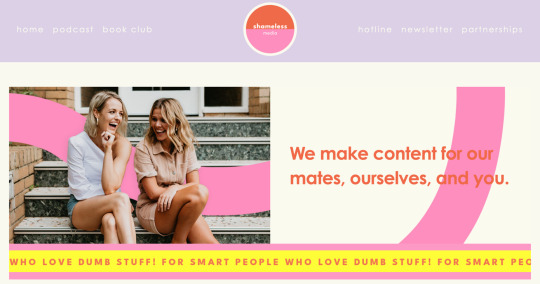
At first glance: Layout is easy to look at. Visually appealing. All relevant info seems to be there.
My thoughts: Nice design, but not as much interactivity as I would have liked. When I tried looking for more information on the founders and organisation, something like an About Us section for example, there was none. Neither was there any resource or material on the business side of things (annual reports or data analytics or anything of the sorts).
One may excuse this considering the age of the organisation. However, I believe SM might benefit from a website update or revamp. It will certainly be helpful for those like me who are curious, who do research on the firm and would therefore like more access to information.
3. Instagram
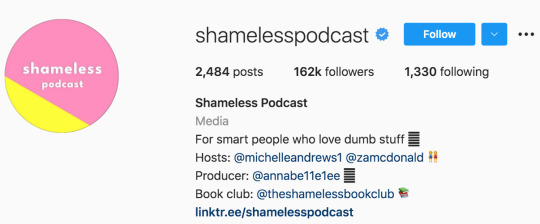
At first glance: Quite large following. Relatively high audience engagement. Content layout not my personal taste, but appealing overall.
My thoughts: Shameless has great social media presence, especially on Instagram. The company made good efforts in interacting with followers. There are the ‘Your say Fridays’, polls and Q&A every other day on Stories. Users regularly comment on posts (memes, podcast updates & announcement), and many get replies from admin.
Overall, Shameless is doing very well with social media engagement and audience interactions.
4. Facebook
At first glance: Not much to see/do as this is a private group. Nice cover image though.
My thoughts: Large community of readers of nearly 34,000 members. The group has been active since 2019. While discussion threads cannot be publicly viewed, those interested in the content can find related episodes on the Shameless podcast.
Over on Instagram, there are links in bio to the book-selling site for each month’s pick. Makes me wonder whether or not these are affiliate links.
5. LinkedIn
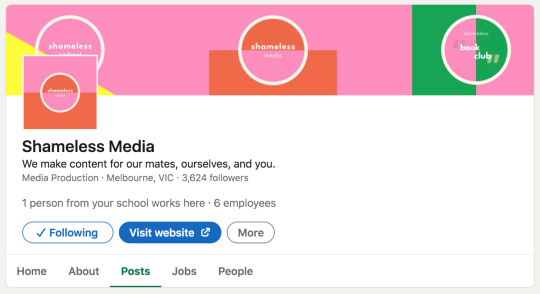
At first glance: Small-to-medium sized following. Appealing visuals, though not too much information.
My thoughts: I have seen the Shameless LinkedIn profile before, but has only started following them recently. The account is not too active, the latest post was from a few months ago. Perhaps this is because the content that circulates on LinkedIn often revolves around business culture, not the usual focus by SM. Most of the posts thus far are general announcement and job openings.
In the future, SM might be benefit from a more active LinkedIn page, so as to not only attract new audience and potential talents, but also to establish their presence more firmly among competitors in the corporate world.
DIGITAL STAKEHOLDER ENGAGEMENT
The corporate brand is constantly being co-created by organisation with their stakeholders. Dialogical communication is said to enhance this along with corporate reputation (Gundolf et al. 2018; Ozer 2020; Rosenberg & Seager 2017).
In reality, what might this look like?
From tactics to dialogic communication in digital media, let’s look at how SM has been engaging with stakeholders.
Dialogical communication in digital media
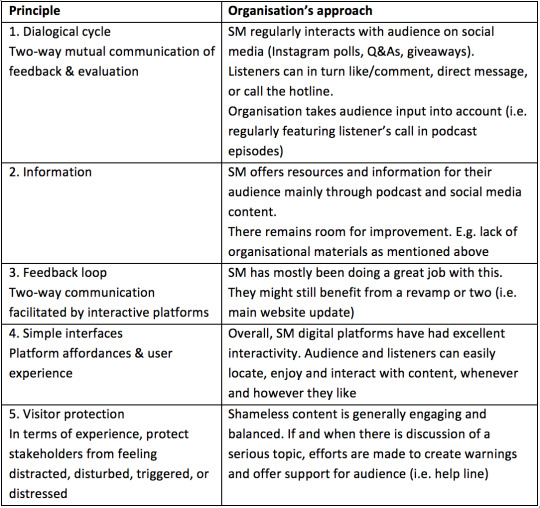
Tactics
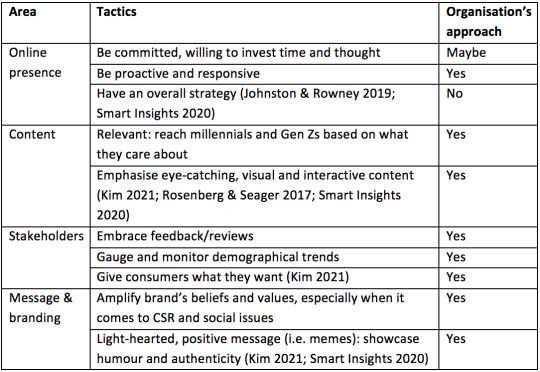
Potential areas of improvement
Lack of strategy
Upscaling the business
Other types of content, especially video
CONCLUSION
So far, leveraging social media has helped Shameless achieve their goal and stay true to their brand. “Win their niche, core audience, nurture specific community of mostly young working women” (Gillezeau 2021).
The company’s success is in no small way thanks to the relationship they have with their audience. SM has intimate understandings of what the audience wants, and are able to deliver it.
This is in large part due to the founders being in the same demographics as their audience. As McDonald put it, “[W]e wanted to tap into a younger demographic that we thought were generally being ignored by mainstream media” (Forbes 2021), which explains the company slogan.
“We make content for ourselves, our mates, and you”.
Branding and content wise, SM is doing a good job capitalising on the trends, particularly with interactive content, content marketing, and online content communities (Clark-Keane 2021; Thomson 2019).
Yet, it is also important to note the fortunate position SM finds themselves in. As a millennial start-up, they are already advantaged by having skills in digital media and technologies.
Nonetheless, through forces of strategic digital communication, Shameless Media has been successfully engaging with their stakeholders through a combination of clever branding and content marketing.
---
REFERENCES
Clark-Keane, C. 2021, ‘7 Content Marketing Trends to Watch in 2021’, Wordstream, https://www.wordstream.com/blog/ws/2020/11/23/content-marketing-trends
Forbes, T. 2021, ‘How I Do It: Shameless Media’s Zara McDonald and Michelle Andrews on building their empire’, Fashion Journal, https://fashionjournal.com.au/life/how-i-do-it-shameless-media/
Gillezeau, N. 2021, ‘Shameless Media: The podcast start-up that’s rejecting big offers’, Australian Financial Review, https://www.afr.com/companies/media-and-marketing/how-they-built-it-shameless-media-20210330-p57fbu
Gundolf, K., Jaouen, A. & Gast, J. 2018, ‘Motives for strategic alliances in cultural and creative industries’, Creative Innovation Management, vol. 27, pp. 148-160, DOI: 10.1111/caim.12255
Johnston, J. & Rowney, K. 2019, ‘Social networks’, Media Strategies: Managing Content, Platforms and Relationships, Taylor & Francis, Sydney, pp. 75-103.
Kim, K. 2021, ‘How to make sure you’re marketing to Gen Z the right way’, Sprout Social, https://sproutsocial.com/insights/marketing-to-gen-z/
Ozer, D. 2020, ‘Organisations’ use of social media from the perspective of dialogical communications and marketing-oriented public relations’, In B.O. Aydin, S. Gurbuz & O, Dugan (eds.), Public Relations in the Networked Publics, Peter Lang, Frankfurt, pp. 211-235.
Rosenberg, M. & Seager, P. H. 2017, ‘The Big Picture: Four Trend that Change Everything’, Managing Media Businesses, Retrieved from ProQuest EBook Central, DOI 10.1007/978-3-319-52021-6_1
Smart Insights 2020, ‘7 ways to reach and influence millennials using social media marketing’, https://www.smartinsights.com/social-media-marketing/social-media-strategy/7-ways-to-reach-millennials-through-social-media-marketing/
Tench, R. & Yeomans, L. 2017, ‘Exploring Public Relations’, Global Strategic Communication, Pearson Education, Harlow, Available from: ProQuest EBook Central (14 August 2021).
Thomson, C. 2019, ‘Top Marketing Trends For 2020’, Forbes, https://www.forbes.com/sites/forbesagencycouncil/2019/10/03/top-marketing-trends-for-2020/#6889ba113d5d
-END-
4 notes
·
View notes
Text
Virtual Community of Practice (CoP): Parasocial Relationships in the Internet Age
Out of all the CoPs I’ve been a part of online, YouTube is without a doubt the one I invest my time in the most. 16 years old, which seems like a long time and at the same time not at all, YouTube is the most popular video-sharing platform out there for user-generated content.
Over 2 billion users visit the site each month to watch their favourite vlogs, music videos, sports highlights, news and more. Every day, people watch over a billion hours of video and generate billions of views.
I’ve been watching YouTube ever since I was 10-11. This platform has been there with me through my experimenting tween phase, my teenage angst, and now, my aspirational and hopeful (young) adulthood.

If you’re a long-time connoisseur like me, or also ‘involuntarily’ grew up on the Internet, you probably recognise many of these faces.
Most of the content I watch falls under the lifestyle category: everyday life, fashion/beauty, health/wellness, academic (books & studying), and professional (jobs, careers, finance) etc., Popular lifestyle content and successful lifestyle creators tend to be aspirational, idealised or even romanticised.
A few observations about this CoP:
1. The Domain is YouTube content in general, and lifestyle content in particular. Members are those who are interested in seeing ‘ordinary’ life being represented on-screen, those who like to watch relatable content they can identify with.
2. The Practice involves consuming and interacting with lifestyle-branded content and creators (for the creators are also products themselves), in the form of “Like, Share, Comment, and Subscribe” – the usual YouTuber slogan, plus other cross-platform engagement (following creators on Instagram, Twitter, TikTok, etc.).
3. The Community is built up and reinforced by both the creators and user audiences through Mutual Engagement (the illusion of doing things together’, albeit virtually), and Shared Repertoire (a way of contributing to and generating discourse about millennial-gen Z life in the 21st century).

Interestingly, there is another illuminating aspect about my participation in this CoP. My long-term fascination and consumption of lifestyle YouTubers seems to resemble something like a parasocial relationship*.
*A kind of one-sided relationships in which individual identifies with a celebrity or public figure, a person they see on-screen, usually famous singers & actors, with whom there is an illusion of a personal connection/relationship.
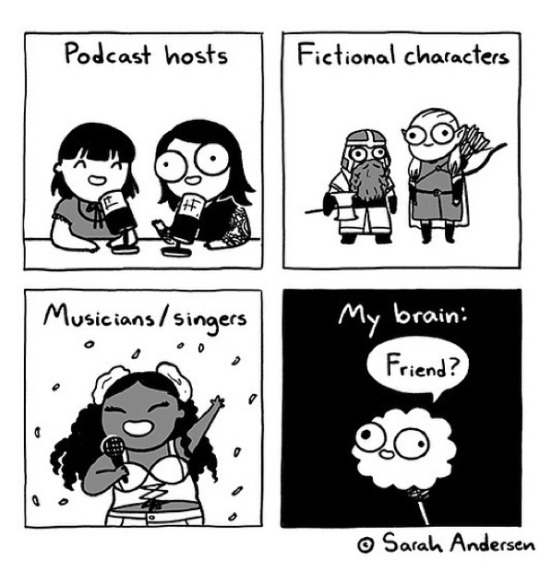
Despite hopes and ideals of a Networked Society, we are living in an increasingly fragmented and isolating society. Parasocial relationships, as such, can give individuals a sense of identification, comfort and belonging, without real risks of emotional pain or trauma, and much more freedom and flexibility to ‘opt-out’.

It is also important to note that this kind of relationship / CoP participation, remains bounded by the structures of globalisation, capitalism, inequality, privilege and so forth, in which one party profits off the other. In this case, the individual creators and platforms receive financial & economic benefits from the user-consumer watching them.
Alright, now that I'm doing writing this blogpost, back to YouTube watching.
---
See more on Parasocial Relationships:
https://sk-sagepub-com.ezproxy.lib.rmit.edu.au/video/parasocial-relationships
https://www.teenvogue.com/story/on-parasocial-relationships-and-the-boundaries-of-celebrity
https://www.nytimes.com/2021/05/05/parenting/influencers-social-media-relationships.html
https://www.nytimes.com/2021/05/13/learning/do-you-feel-youre-friends-with-celebrities-or-influencers-you-follow-online.html
More on YouTube:
https://www.youtube.com/intl/en-GB/about/press/ (statistics)
youtube
0 notes
Photo

Hello there,
After having had this page for 9 years (thank you Tumblr’s anniversary reminder), mostly for re-blogging memes and funny commentary as a teenager, I’m now repurposing this for my professional & academic endeavours.
If you’ve also grown up on Tumblr, or now doing the finer things in life (i.e. being an adult), or just at all curious or interested in my journey in general, you’re welcome to follow along with me.
Here is where I’ll be showcasing my uni/work projects that are part of my training into becoming a professional communicator and media practitioner, among other fun stuff (living in the beautiful city of Melbourne, Australia).
Not too long ago, I completed my Bachelor degree from Monash University. Now, at RMIT University, I’m doing a Masters degree in Communication, which I hope will continue to challenge me and take me out of my comfort zone.
As an avid academic scholar, media consumer & now producer, I believe that when it comes to the world of communication and media, the possibilities are endless. If you’re interested / looking to work in this field, Public Relations and/or even Marketing (or if you’re just nosy), I hope this will be a fun learning experience for both of us.
Feeling nostalgic, yet excited. With all that being said, welcome to my Digital Portfolio, and I’ll see you shortly! :)
Zoe
0 notes
Text
you know what? the years really do start coming and they really don’t stop coming
262K notes
·
View notes
Text
ok universe, i’m ready to feel good things. make me feel good things.
2M notes
·
View notes
Text
i hope the rest of july treats you well, august leaves you happy, september fills you with warmth, october gives you closure, november gives you new beginnings, december gives you A love of your life, and 2018 is fruitful and you love and are loved
289K notes
·
View notes
Text
*sees dog* nice *sees dog wearing a bandana around its neck* nice
542K notes
·
View notes
Text
Best advice I’ve received so far
the time you take being jealous of other people’s success is the time you could be using to build your own
you’re never going to “feel like it”
doing and practicing now is better than waiting for the perfect moment
eliminate people with toxic habits from your life
you are in control. Everything you’ve done up to this moment led you here. Therefore, your future is determined by what you do now.
everything is as it should be and only later in life you can connect the dots.
self discipline will give you freedom. consistency will give you results
everything is temporary. You should find freedom in this concept
the rich stay rich acting poor and the poor stay poor acting rich
being healthy means finding a balance between the good and the bad
the people that outranked you have outworked you.
you can’t be grateful and negative at the same time.
Meditate on these statements. They are so very powerful! Xxx
74K notes
·
View notes
Text
me (looking at my plants): why don’t we ever talk
174K notes
·
View notes
Text
I don’t need a significant other just a significant income
555K notes
·
View notes
Photo
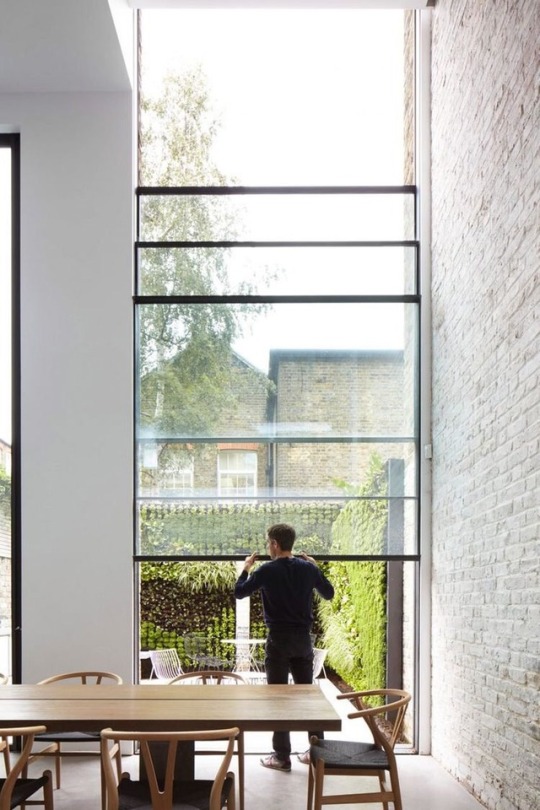


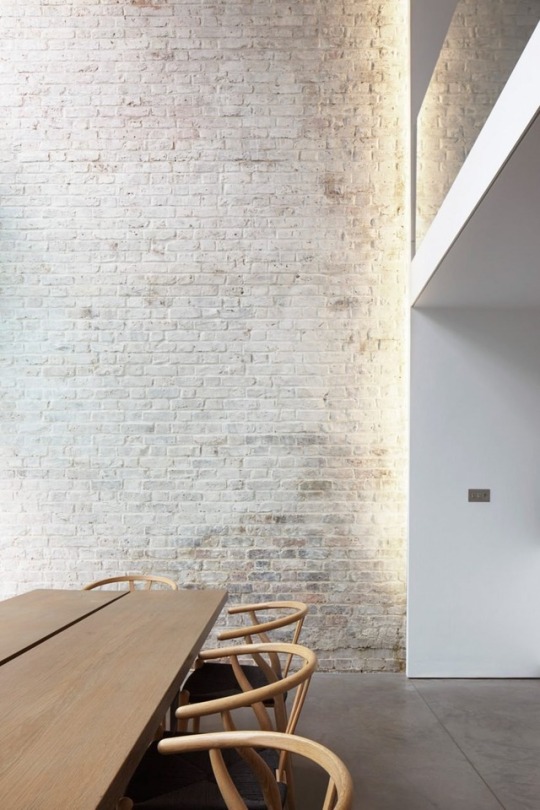

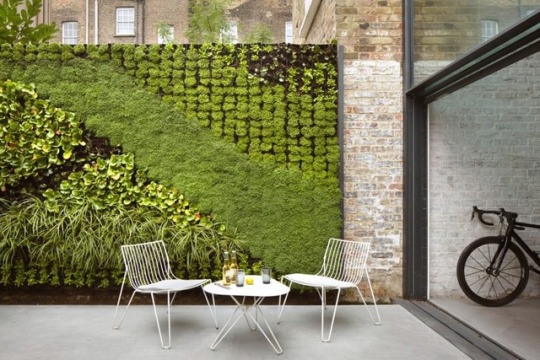

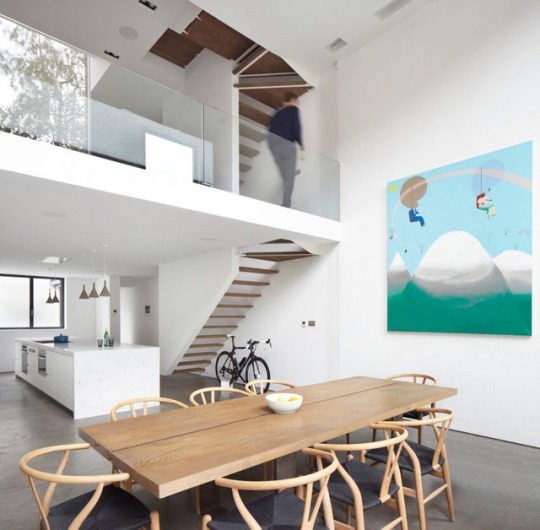


Slot House, London by Studio Octopi.
Photography by Jack Hobhouse.
483 notes
·
View notes
Conversation
business email glossary
thanks in advance: get this done by the time i press "send"
thanks for your interest: why'd you have to bring this up
would you be so kind: fucking do it
best: i have never physically met you
all best: this conversation is over
all my best: i wish you would die
happy to help: this is the easiest thing in my inbox
i hope this helps: i've done all i'm willing to do
i did a bit of research: i googled it, because you're too lazy to
sorry to chase: answer my email
so sorry to chase: answer my FUCKING email
i am really sorry for being a pest but: i am LIVID that you are ignoring me
please contact my colleague: this isn't my problem
i'm copying in my colleague: this isn't my problem and i am thrilled about it
i'll check and get back to you: i might forget to
i'll let you know when i hear anything: i will forget to
can you check back with me in a week?: i'm hoping you will forget to
per our earlier conversation: i just yelled at you on the phone
great to chat just now: you just yelled at me on the phone
thanks!: i'm not mad at you
thanks!!: please don't be mad at me
thanks!!!: i'm crying at my desk
please advise: this might be your fault
kindly advise: this is entirely your fault
mind if i swing by?: i'm already in the elevator
can you confirm for me: you told me before and i deleted the email
sorry if that was unclear: i think you're an idiot
let me know if you need anything else: please never contact me again
414K notes
·
View notes
Photo


i finally finished setting up my workspace in my new apartment and honestly??? i’m completely in love
57K notes
·
View notes
Text
🌼🌻study smarter🌻🌼
(here are some study tips straight from my psych notes)
1. interest: the brain prioritizes by meaning, value, and relevance so u remember things better if ur interested
find a study partner
do extra practice or research
teach it to someone else (this works so well!)
2. intent: be actively paying attention. very little learning actually takes place without attention
use a concentration check sheet (every time u get distracted, put a check on ur sheet. this is supposed to program ur mind to pay attention)
while u read, talk back to the author
ask questions during lectures (this is scary ik!! but do it!)
3. basic background: make connections to what u already know
preview and skim the material before u read it. or google it!
write out a list of vocab words before a lecture and leave some spaces between them to fill in during the lecture
read ahead of lectures
watch crashcourse tbh
4. selectivity: start by studying whats important
look for bolded words, graphics, pictures, chapter review questions in ur readings
listen for verbal clues like emphasis and repetition during lectures
make urself a study guide as u read and write down questions for urself to answer later as review (kinda like cornell notes)
5. meaningful organization: u can learn/rmr better if u group ideas into diff categories
apply vocab words to ur life
make flashcards and sort them (try not to have more than seven items in one category!)
use mnemonics
6. recitation: saying ideas aloud in ur own words strengthens synaptic connections! when u say something aloud u r forcing urself to pay attention
after u read, ask urself questions
talk abt what u learned w/ classmates outside of class
again, teach someone else
7. visualization: ur brain’s quickest and longest-lasting response is to images
convert info into a chart or graph
draw it out
make a mental video of a process
look at picture/video examples
8. association: memory is increased when facts are consciously associated w something u already know. memory = making neural connections
ask urself: is this something i already know?
9. consolidation: give ur brain some time to establish a neural pathway
make a list of what u remember from class
review notes at the end of the day, every day
stop after reading each prg to write a question in ur notes
make ur own practice quiz
10. distributed practice: we all know cramming doesnt work but we do it anyway! but yeah short and frequent study sections work better
make a daily/weekly study schedule
create a time budget/time tracker (track everything ur doing for a week and see how u can be more efficient w/ the time u waste)
divide the reading/vocab by the number of days before an exam and do a little bit each day (u can use sticky notes to divide ur reading)
other tips:
stop stressing! this sounds stupid and it isnt going to be easy, but anxiety causes u to lose focus. try ur best to think positively. sleep a lot. minimize ur caffeine intake. take a walk maybe
when u need to remember something, look upward or close ur eyes (when ur eyes are open ur using visual parts of ur brain that u might not need to be using)
find a rival! (like the person right above u in class rank) secretly compete w/ them (envy can improve mental persistence bc it makes u focus more intensely) but dont overdo it!
walking and sleeping build memory storage in ur brain
eat flavonoids! (grapes, berries, tea leaves, cocoa beans make neurons in the brain more capable of forming new memories + increase blood flow to the brain)
obstacles force ur brain to try harder, so space learning lessons apart or create a puzzle to solve or change ur physical setting
27K notes
·
View notes
